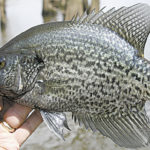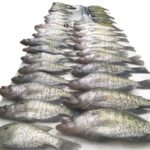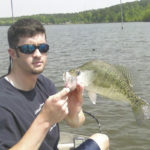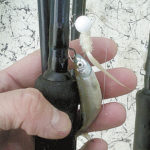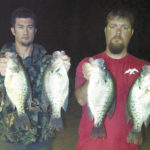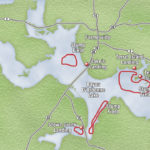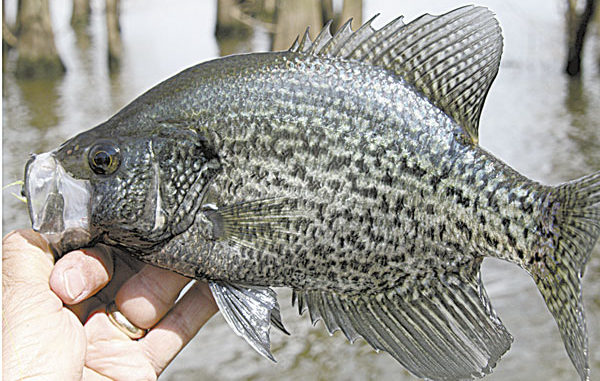
If the thought of spawning crappie automatically makes you want to move to shallow water, you’re missing out on the real slabs.
Die-hard crappie fishermen look forward to spring every year because that’s when those delicious fish are easy to pattern. When the dogwoods start to bloom, you know the crappie will be heading to shallow cypress trees or brushy banks to spawn.
Or will they?
On North Louisiana’s Lake D’Arbonne, some white perch seem to stay in deep stump-filled waters throughout the spawn, and those fishermen who know where to look for them can consistently fill their coolers.
Clark LaBorde is one perch jerker who has spent several years studying this particular pattern.
“I’ve been crappie fishing for around 19 years now,” he said. “I grew up fishing with my dad, Ronnie, who taught me a lot about fishing, and always took time to get my brother and me in the outdoors.”
LaBorde has a theory as to why big female crappie can be caught out of D’Arbonne’s deep stump fields throughout the spawn.
“In March and April, fish tend to move in to spawn,” he said, “but they don’t stay in shallow water for their entire spawn period that usually lasts around a month.
“A female only stays on the nest for 10 to 20 minutes at a time. They stay in shallow water just long enough to lay a portion of their eggs and then they move back out into deep water to feed. The male then moves in on the nest to protect the eggs.
“It is necessary to remain out of the shallows if you want to catch high numbers of slabs. If a big female crappie is in and out of shallow water for a total of one hour a day laying eggs periodically, it makes more sense to fish deeper water because that’s where they’ll be the other 23 hours of the day.”
According to LaBorde, these staging fish can be found around stumps in water up to 24 feet deep, but holding between 10 and 15 feet depending on where the baitfish are. Two of his favorite places to fish on D’Arbonne are the deeper stump fields in the Stowe Creek inlet and around Terrel Island. He looks for 16 to 24 feet of water, and lets out about 10 feet of line.
Stowe Creek, in particular, can hold some nice fish.
“The big 16-inchers stage up there in April,” LaBorde said.
I’m a creature of habit, and have always probed D’Arbonne’s shallow cypress trees for my springtime white perch. But after pondering LaBorde’s theory, and having no success in my usual places, I decided to try out the lake’s stump fields during last year’s spawn.
Actually, a fitful night’s sleep is what really motivated me. I hadn’t planned on getting up early that cool March day, but woke up before daylight and couldn’t go back to sleep, so I decided to go fishing. When I arrived at D’Arbonne, the Stowe Creek landing was already crowded with vehicles, and there were a few boats in the stump field out from the launch.
The morning was cool, with the temperature hovering in the upper 40s, and there was a slight breeze rippling the water. Heading out from the launch, I decided to try my luck on the far side of the stump field where the other boats were.
Some crappie fishermen like to use a spider rig with as many as eight poles jutting out from the bow of the boat. But to me, feeling the tell-tale “thump” that comes when a slab grabs the jig is the best part of fishing, and you don’t get that when your pole is resting in a rod holder. Therefore, I stick with a pole in each hand and slowly troll through the stumps looking for a bite.
On this particular morning, I had each pole rigged with two 1/8-ounce jigs tied about a foot apart. One was a Black Lake gray/chartreuse hair jig and the other was a Bobby Garland solid body jig in the blue thunder color.
To be honest, I really wasn’t expecting much. Everybody knew the white perch were moving up shallow, and I couldn’t shake the feeling that I was just wasting my time. But in short order, I caught three nice crappie and a white bass and lost two more perch.
Suddenly, the unpredictable March wind picked up, forcing me off the flat and to another 10-foot stump field on the west side of Highway 15. Just as I dropped the jigs down close to the bottom, a slab immediately hammered one of them. I laid down the other pole to wrestle the fish in, but it was nearly jerked overboard when another large white perch snatched one of its jigs.
Within 10 minutes after pulling those two fish into the boat, I landed another double. Hmmm, I thought, I might be on to something here. I soon noticed that everyone on the flat was catching fish, but the bite dropped off dramatically after 10 a.m. Nonetheless, I wound up catching 50 and kept 33. Several of those registered over 1½ pounds on my digital scale. Most were large, egg-filled females, but a couple were beautiful dark-colored males.
Tommy Brister is another fisherman who targets the stump fields during the spawn. Last year he discovered how important it is to pay attention to your depth finder when drifting across the flats.
It was the first week of April when the spawn was just getting under way, and Brister decided to try out a 10-foot flat he had never fished before.
“I had four poles set out, and was fishing near the bottom,” he said. “Then I looked at my depth finder and it said 8 feet. Uh oh, I thought, I’m about to get hung up.
“One of my poles was bent over and I reached over to pick it up and had a good fish. I caught about six in 10 minutes, and then drifted back into the 10-foot water. I fished another hour and a half, and didn’t catch a thing, and then it dawned on me I ought to go back and try that ridge again. As soon as I got back on it, I had another fish. In the two hours or so before dark I caught 22.”
Apparently, the white perch were coming up onto the ridge to spawn and then dropping back into the deeper water to feed. Brister noted that all of the ones he caught were males.
A few days after getting Brister’s report, I decided to try the same area. I got there not long after daylight, and saw only a couple of boats out on the water. It was a cool morning and the weatherman had predicted a stiff breeze, so I bundled up and headed out before conditions deteriorated. Slowly motoring through the maze of stumps, I kept one eye glued on the depth finder so I wouldn’t miss the narrow ridge Brister had described.
After zigzagging through the flat for 15 minutes without finding the ridge, I finally decided I must have misunderstood Brister’s directions. The water was beginning to get a bit choppy, so I decided to start fishing at the edge of the stumps closest to the bank and work my way out toward deeper water.
I dropped one tandem jig rig down close to the bottom, set the pole on the bow deck, and picked up my other pole to get it ready. Out of the corner of my eye, I saw my first pole dip down sharply. Quickly setting down the pole in hand, I grabbed the other one and started fighting a good-sized crappie. Then the other pole jumped and I had to grab it before it went overboard. With two good fish on both poles, I held one between my knees to land the first one and then brought in the other.
I caught a couple more perch in the area, but the wind got so bad I had to move around a point of land to calmer waters. Once again I found myself fighting two fish at once as soon as I set out the jigs. Later in the morning, I moved to a third spot, and the same thing happened. It was sort of weird to have three doubles at three stops and not catch much afterward, but at least it proved the white perch were in the stump fields.
Returning to the same area several times over the next few weeks, I always caught enough crappie for a mess. Although I never got a limit, it was much better fishing than I had around the shallow cypress trees. And, besides, you can’t go wrong spending a warm spring afternoon on the lake.
